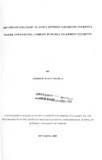Drivers of Strategic Alliance Between Safaricom and Kenya Power and Lighting Company in Mobile Telephony Payments

View/
Date
209-10Author
Masila, Andrew N
Type
ThesisLanguage
enMetadata
Show full item recordAbstract
User demand for convenient and intelligent ways in which to make payments for goods an
services using the mobile phone is creating exciting opportunities for those organizations that are part of the mobile payment ecosystem. The ecosystem includes mobile operators, banks, retail merchants, handset manufactures, and other variants as necessary. The telecommunications industry in Kenya has become pivotal in day to day life owing to its reach and convenience. As such it has found application in the financial services sector more so in the settling of transactions. This has created a host of opportunities and new business structures where various organizations are organizing into alliances to take advantage of this capability. This study was keen to follow on these developments by looking at mobile telephony payments using M-Pesa of Kenya Power & Lighting Company (KPLC) electricity utility bills. This study was conducted as a survey within Safaricom and KPLC organizations.
Primary data was collected through questionnaires administered to the management at both organizations involved in setting up of the alliance. Analysis of the data collected was
conducted using descriptive statistics where mode was the preferred method. This was used to determine whether the driver was key to either of the two organizations in setting up the alliance. As per the findings, both organizations had different key drivers for engaging in the alliance though a few were shared i.e. to enhance customer value and advancement of technology in the telecommunications sector providing new opportunities. For Safaricom this was mainly driven by competition and need to guard against declining Average Revenue per User (ARPU). KPLC was mainly driven by the need to enhance customer value and with time as subscription grows it is expected the organization will enjoy benefits arising out of efficiencies associated with technology mainly in form of improved revenue collection. The symbiotic fit in setting up the alliance studied is enhanced by the fact that both organizations are likely to offer different services to the same set of customers. This creates an opportunity from which new business models can be formed. Further research can be conducted in terms of looking at other mobile telephony payment solutions and also looking at the mobile payments ecosystem in Kenya as a whole.
Publisher
University of Nairobi School Of Business, University Of Nairobi
